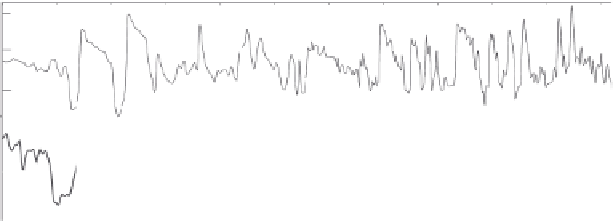Geoscience Reference
In-Depth Information
18
O measurements from a sediment core off Portugal (both proxies are
from the same core and thus relative timing between both series is exact) compared to the simulated surface temperature
and mean ocean temperature obtained with SIO. SIO simulates both records with some fidelity and shows that there is
indeed a
π
/2 phase shift between the two time series. As shown in Figure 9, ECBILT-CLIO also reproduces this
relationship. It is easy to demonstrate that the benthic record (a likely proxy for deep ocean temperature or mean ocean
temperature) closely correlates with the normalized time integral of the planktonic record (a proxy for SST). Both proxy
records are displayed using the Greenland Ice Sheet Project Two age model shown on top. It should be noted that the phase
relationship between the planktonic and benthic records is a well-known but unexplained feature of oceanic proxies
[Shackleton, 2000; Saikku et al., 2009].
Figure 8.
Time series of planktonic and benthic
δ
strengthens, and large volumes of warm water transfer heat
polarward, while the deep ocean cools off and freshens. This
is the abrupt warming phase of the relaxation oscillation.
ECBILT-CLIO in Figure 2 and SIO and ECBILT-CLIO in
Figure 9 show that ocean cooling at depth begins gradually
after the sea ice cover retreats accelerated by the positive sea
ice-albedo feedback. Vigorous convection follows that keeps
the ocean
Of course, models tell but a very incomplete picture of
how the ocean system may function. Worse yet, the picture
just described may have little to do with reality [e.g., Wunsch
and Ferrari, 2004]. Nevertheless, it is generally believed that
the oceanic thermohaline circulation is driven by high-latitude
surface cooling, as the intense heat loss to the atmosphere
causes ocean surface water to reach its highest densities at
some places in the high latitudes. This cold dense water then
sinks into the deep ocean, spreads out along the ocean
bottom, and
s gradients of temperature salinity and density
steep, while the SST slowly cools in the Arctic atmosphere,
allowing sea ice to start growing back and eventually reach
its maximum extent (this is the abrupt cooling phase of the
relaxation oscillation). As the ocean surface is covered up by
sea ice, the cycle begins anew.
'
finally returns to the surface by uniform upwell-
ing through the interior ocean. Were this the only driving
force, the ocean basins would eventually fill with cold dense
water, the sinking of surface water would stop, and the





















































































Search WWH ::

Custom Search